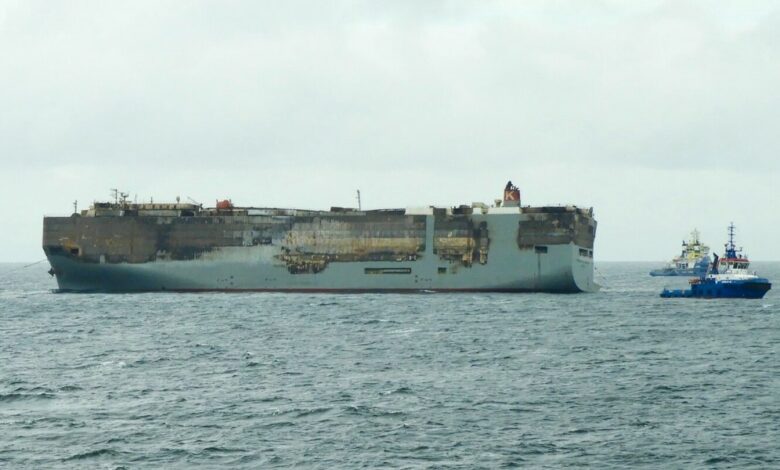Fire-damaged Fremantle Highway going to Eemshaven port

The Dutch authorities have chosen Eemshaven port as the final destination for the fire-damaged car carrier Fremantle Highway.
After consultation with all parties involved, Markus Harbers, the Dutch minister of infrastructure and water management decided that the car carrier would be towed to Eemshaven. The ship is currently 16 km from Schiermonnikoog and Ameland.
Eemshaven is only 64 km away and its existing infrastructure and facilities are adequate for the next steps in salvaging the ship. The port was also chosen due to the deteriorating weather conditions.
The Directorate-General of the Dutch Ministry of Infrastructure and Water Management – otherwise known as Rijkswaterstaat – claimed that the risks were limited by keeping the towage journey as short as possible.
The ship’s exact departure and arrival time depends on the weather, current, and tide. Departure from the current location was scheduled for Thursday morning.
Rijkswaterstaat added that the situation onboard the cargo ship was still stable. Most of the ship has been inspected and there are no indications of a fire.
During the tow to Eemshaven, experts will be onboard the Fremantle Highway to monitor the vessel’s status. The coast guard’s ship Guardian and Rijkswaterstaat’s oil response vessel Arca will accompany the car carrier to the port.
The fire broke out on the vessel last Monday night. The vessel had 21 crewmen – all Indian nationals, one of whom died. Also onboard were the pilot and a superintendent. All of them were rescued and the injured crewmembers were taken by ambulance to nearby hospitals with breathing problems, burns, and broken bones.
Early attempts to salvage the vessel were not fruitful as the vessel was too hot for anyone to board. From Friday onwards, temperature and smoke decreased drastically, and a salvage team was able to board the car carrier.
It was decided that the Fremantle Highway would be towed to a temporary location north of Schiermonnikoog to decrease the chance of polluting the Wadden Islands. The tow started on July 30 and the vessel was on location and moored on July 31.
K Line, the company chartering the ship, confirmed to Splash that the total number of cars onboard was 3,783 units – all brand new. Of that number, 498 cars were EVs.
While the coastguard still claims the source of the blaze is unknown there has been widespread speculation that an electric vehicle is again to blame. Such vehicles use lithium-ion batteries that, when on fire, can reach temperatures of more than 2,700 degrees Celsius.

When you state that speculation is that an electric car is “again” to blame, what was the previous ship fire which was caused by a purely electric vehicle? Could you please clarify that statement?
Felicity Ace. Exact cause unknown as ship sank but is irrelevant, known ferocity of electric vehicle battery fires destroys ships even if not fire source. Shipping line Mitsui OSK Lines stopped accepting pure electric vehicle cargo.
Grow up. It doesn’t matter what started the fire (though it almost certainly was an EV) the fact that it burned for so long with such intensity indicates that EV’s were on fire. They are incredibly dangerous when alight and their presence has totalled this ship. Had it been carrying solely ICE,s the ventilation closure system would have rapidly reduced the fire to normal manageable proportions and would have been put out relatively quickly. The ship would have remained intact.
@Michel Coates
Probably the Felicity Ace (september 2022)
https://www.evfiresafe.com/post/electric-vehicle-fires-on-ships-ferries